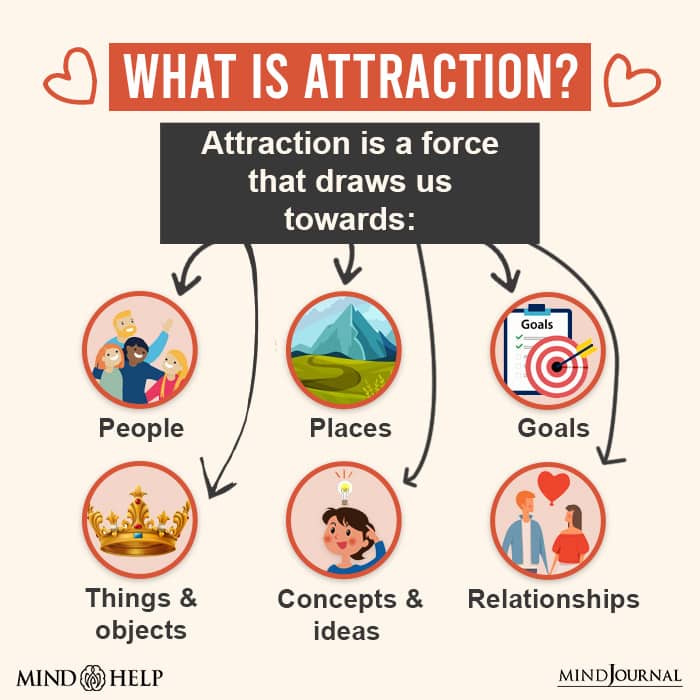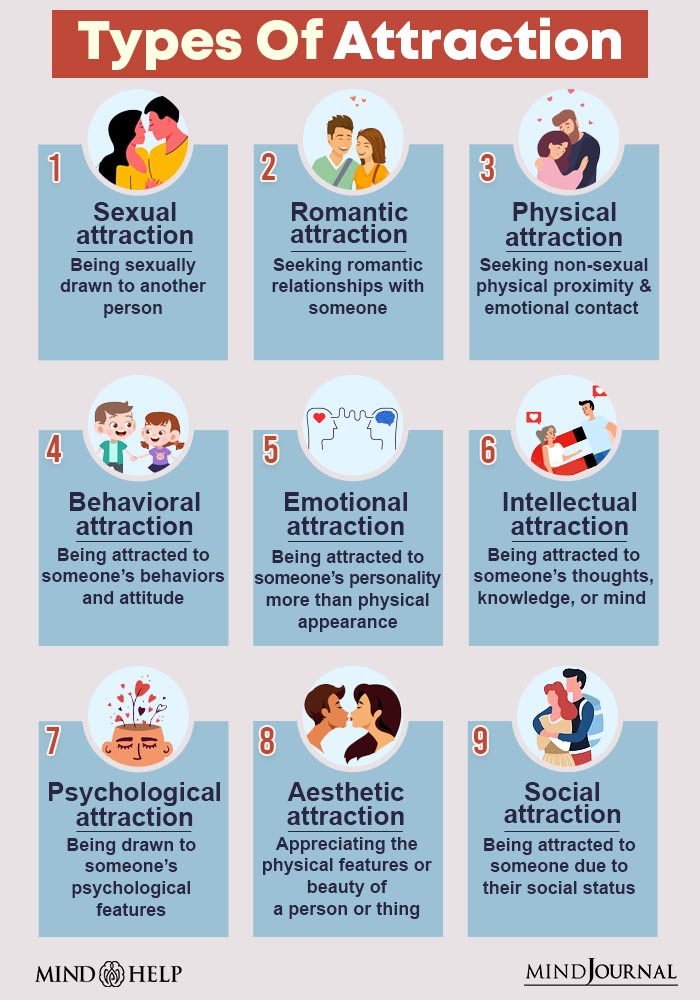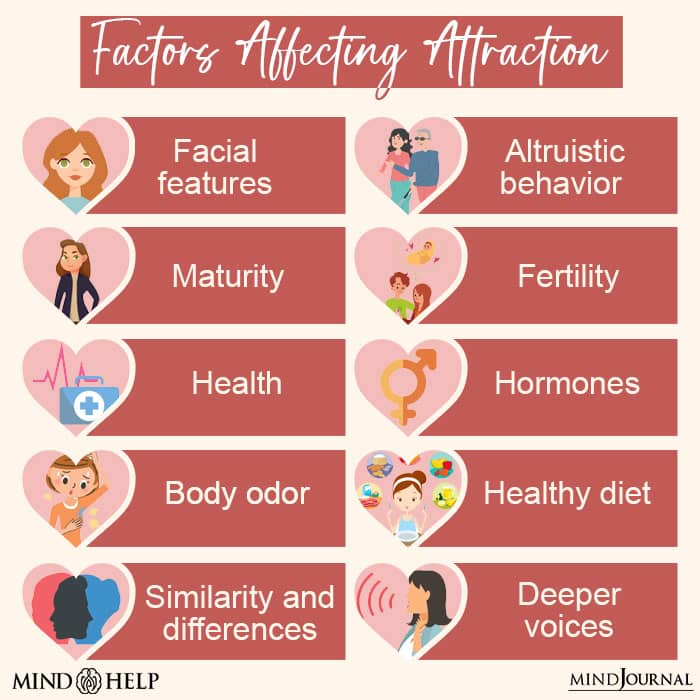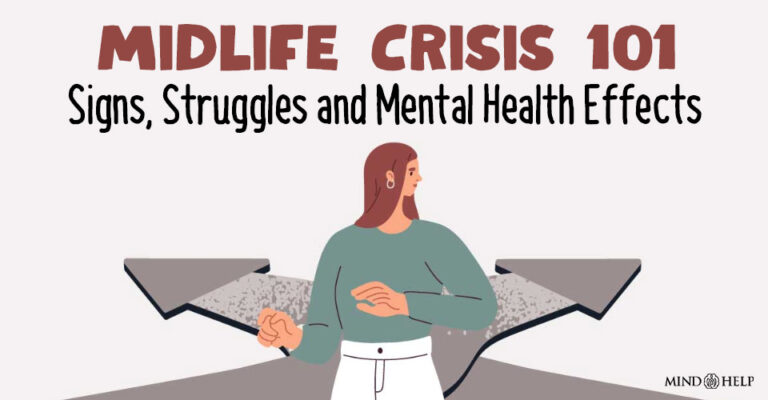Table of Contents
Attraction is a trait or quality which causes interest or desire in certain people or things. Commonly, it refers to a psychological & emotional gravitation we feel towards others we interact with.
What Is Attraction?

According to social psychology, attraction or attractiveness is a force that makes one person feel drawn towards another person. It is an affinity, connection, or ‘spark’ that makes people gravitate towards each other and form friendships or romantic relationships. Studies 1 Mark, K. P., & Herbenick, D. (2014). The influence of attraction to partner on heterosexual women’s sexual and relationship satisfaction in long-term relationships. Archives of sexual behavior, 43(3), 563–570. https://doi.org/10.1007/s10508-013-0184-z reveal that “attraction is important in the formation of relationships,” and “attraction to a partner is an important contributor” to satisfaction in long-term romantic relationships.
It is a natural feeling that makes us desire the company of a particular person. A recent 2020 study 2 Montoya, R. M., & Horton, R. S. (2020). Understanding the attraction process. Social and Personality Psychology Compass, 14(4). https://doi.org/10.1111/spc3.12526 explains that “attraction is an emotion expressed to regulate interpersonal relationships.” However, one can also be attracted to certain things. This quality is often regulated by cognitive appraisals, expression of affiliative behavior and subjective experience, believe the researchers. It plays a fundamental role in initial interactions and in lasting relationships.
It is an unintelligible concept and can be motivated by almost anything. We cannot predict what can make us attracted to someone and not attracted to another person. Although physical attractiveness is a crucial aspect, we can also be drawn to someone due to their intelligence, personality, passion, resources, attitude, mindset, behavior, confidence or how they make us feel. Apart from being attracted to another human being, we can get attracted to –
- Things and objects
- Places
- Ideas and goals
- Relationships and friendships
According to research 3 Malloy T. E. (2018). Interpersonal Attraction in Dyads and Groups: Effects of the Hearts of the Beholder and the Beheld. European journal of social psychology, 48(3), 285–302. https://doi.org/10.1002/ejsp.2324 , attraction is strongly influenced by similarity and familiarity. “Familiarity increases attraction among strangers and has implications for relationship formation,” add the researchers. Another 2004 study 4 Peskin, M., & Newell, F. N. (2004). Familiarity breeds attraction: effects of exposure on the attractiveness of typical and distinctive faces. Perception, 33(2), 147–157. https://doi.org/10.1068/p5028 states “familiarity affects attractiveness.” Moreover, attractiveness can also influence our perception of someone’s personality and character.
One 2010 study 5 Lorenzo, G. L., Biesanz, J. C., & Human, L. J. (2010). What is beautiful is good and more accurately understood. Physical attractiveness and accuracy in first impressions of personality. Psychological science, 21(12), 1777–1782. https://doi.org/10.1177/0956797610388048 found that beauty is typically considered “good”, however, such an assumption may not necessarily be accurate all the time. Your distinct impressions of another individual’s attractiveness is positively associated with the “positivity and accuracy of impressions.” The study adds “people do judge a book by its cover, but a beautiful cover prompts a closer reading, leading more physically attractive people to be seen both more positively and more accurately.”
Read More About Relationships Here
Elements Of Attraction
In order to better understand the concept of attractiveness, we need to understand its two primary elements, which include-
1. Interpersonal attraction (IA)
It refers to the attraction between two people that leads to the development 6 Huston, T. L., & Levinger, G. (1978). Interpersonal attraction and relationships. Annual review of psychology, 29, 115–156. https://doi.org/10.1146/annurev.ps.29.020178.000555 of romantic or platonic relationships. It can involve love, lust, admiration, liking and friendship. It is about how much one person likes another individual, feels drawn towards them and is unable to resist them.
Environmental factors, such as weather, temperature and noise, often play a vital role in determining attractiveness towards another person. Other factors like physical and sexual attractiveness, similarity 7 Klohnen, E. C., & Luo, S. (2003). Interpersonal attraction and personality: what is attractive–self similarity, ideal similarity, complementarity or attachment security?. Journal of personality and social psychology, 85(4), 709–722. https://doi.org/10.1037/0022-3514.85.4.709 , proximity & reciprocity 8 Luo, S., & Zhang, G. (2009). What leads to romantic attraction: similarity, reciprocity, security, or beauty? Evidence from a speed-dating study. Journal of personality, 77(4), 933–964. https://doi.org/10.1111/j.1467-6494.2009.00570.x are also influencing factors. This desire for proximity among individuals is often based on internal motivations, specific characteristics or features and shared experiences.
According to a 2001 research paper 9 Aron, A., & Lewandowski, G. (n.d.). Interpersonal attraction, psychology of. ScienceDirect.com | Science, health and medical journals, full text articles and books. https://www.sciencedirect.com/science/article/pii/B0080430767017873 , “Interpersonal attraction usually refers to a positive attitude regarding another person, often including the desire to enter and maintain a relationship with this person, and typically subsumes liking and loving.” It involves three primary aspects – cognitive, affective and behavioral components leading to positive beliefs and feelings for the person and the tendency to approach them for interaction.
2. Physical attractiveness
It refers to the level of attractiveness an individual has based on their physical features. A person whose physical appearance is aesthetically gratifying or conventionally beautiful is often regarded as desirable or sexually attractive. However, physical attractiveness is only one of the components of attraction. It is mainly influenced by facial symmetry 10 Little A. C. (2014). Facial attractiveness. Wiley interdisciplinary reviews. Cognitive science, 5(6), 621–634. https://doi.org/10.1002/wcs.1316 , individual preferences and sociocultural values. Apart from these, biology and hormones 11 Le Moëne, O., & Ågmo, A. (2018). The neuroendocrinology of sexual attraction. Frontiers in neuroendocrinology, 51, 46–67. https://doi.org/10.1016/j.yfrne.2017.12.006 , such as body odor, can also influence physical and sexual attractiveness.
Research 12 Critelli, J. W., & Waid, L. R. (1980). Physical attractiveness, romantic love, and equity restoration in dating relationships. Journal of personality assessment, 44(6), 624–629. https://doi.org/10.1207/s15327752jpa4406_10 reveals that dating and romantic relationships are mainly influenced by physical attractiveness. We often feel more drawn towards partners who are seen as physically attractive. According to a 2009 study 13 Luo, S., & Zhang, G. (2009). What leads to romantic attraction: similarity, reciprocity, security, or beauty? Evidence from a speed-dating study. Journal of personality, 77(4), 933–964. https://doi.org/10.1111/j.1467-6494.2009.00570.x , “The strongest predictor of attraction for both sexes was partners’ physical attractiveness.” It has also been observed that men tend to value physical attractiveness more than women. Studies 14 Gordon, R. A., Crosnoe, R., & Wang, X. (2013). Physical attractiveness and the accumulation of social and human capital in adolescence and young adulthood: assets and distractions. Monographs of the Society for Research in Child Development, 78(6), 1–137. https://doi.org/10.1002/mono.12060 have also found that being physically attractive can also result in certain long-term socioeconomic advantages.
Understanding Attraction
Research indicates that interpersonal attraction strongly influences all of our daily lives. While it’s absence can lead to negative emotions and adverse interpersonal behavior, IA is the key for developing meaningful relationships. It can also lead to improved mental, emotional and physical well-being 15 Gómez-López, M., Viejo, C., & Ortega-Ruiz, R. (2019). Well-Being and Romantic Relationships: A Systematic Review in Adolescence and Emerging Adulthood. International journal of environmental research and public health, 16(13), 2415. https://doi.org/10.3390/ijerph16132415 as social and romantic relationships directly impact our overall health and life satisfaction 16 Amati, V., Meggiolaro, S., Rivellini, G., & Zaccarin, S. (2018). Social relations and life satisfaction: the role of friends. Genus, 74(1), 7. https://doi.org/10.1186/s41118-018-0032-z . Moreover, as the quality of being attractive and being attracted to others is linked with our thoughts, feelings and behaviors, its absence can often result in psychological, interpersonal and adaptive problems and complexities.
Evidence 17 Goddard, N. (2012). Psychology. ScienceDirect.com | Science, health and medical journals, full text articles and books. https://www.sciencedirect.com/science/article/pii/B9780702033971000057 suggests that interpersonal attraction is mainly regulated by the following four factors –
1. Physical attractiveness
Although some people may not consider this as an important factor, physical attractiveness is a crucial element in the development of relationships. Studies 18 Ha, T., Overbeek, G., & Engels, R. C. (2010). Effects of attractiveness and social status on dating desire in heterosexual adolescents: an experimental study. Archives of sexual behavior, 39(5), 1063–1071. https://doi.org/10.1007/s10508-009-9561-z have found that the “attractiveness” of a potential partner is important” to both men and women.
2. Proximity
Being in close proximity 19 Priest, R. F., & Sawyer, J. (1967). Proximity and peership: bases of balance in interpersonal attraction. AJS; American journal of sociology, 72(6), 633–649. https://doi.org/10.1086/224400 to another individual is a strong predictor of attractiveness. How physically close we are with someone and how much time we spend together can influence friendships and relationships
3. Familiarity
Proximity is associated with familiarity, which in turn helps to enhance admiration or affection for someone or something. According to a 2011 study 20 Reis, H. T., Maniaci, M. R., Caprariello, P. A., Eastwick, P. W., & Finkel, E. J. (2011). Familiarity does indeed promote attraction in live interaction. Journal of personality and social psychology, 101(3), 557–570. https://doi.org/10.1037/a0022885 , familiarity has been proven to promote attraction. It found that the more we interact with someone, the more likely we are to feel attracted to each other. The familiarity 21 Finkel, E. J., Norton, M. I., Reis, H. T., Ariely, D., Caprariello, P. A., Eastwick, P. W., Frost, J. H., & Maniaci, M. R. (2015). When does familiarity promote versus undermine interpersonal attraction? A proposed integrative model from erstwhile adversaries. Perspectives on psychological science : a journal of the Association for Psychological Science, 10(1), 3–19. https://doi.org/10.1177/1745691614561682 -attraction link is based on our perceived knowledge, perceived responsiveness, satisfaction and comfort during the interactions.
4. Similarity
Attractiveness is also determined by similar personality traits 22 Lum, K., & Curran, J. P. (1975). Personality similarity and interpersonal attraction in the computer dating situation. The Journal of social psychology, 95(Second half), 233–239. https://doi.org/10.1080/00224545.1975.9918709 , psychological characteristics, perceptions, interests and physical attributes shared among individuals. It acts as a rewarding stimulus leading to positive emotions with similar individuals. According to research 23 Kaptein, M., Castaneda, D., Fernandez, N., & Nass, C. (2013). Extending the similarity-attraction effect: The effects of when-similarity in computer-mediated communication. Journal of Computer-Mediated Communication, 19(3), 342-357. https://doi.org/10.1111/jcc4.12049 , the similarity-attraction effect (SAE) results in “greater feelings of connectedness between people,” when they discover their similarities.
One 2017 study 24 Moore, S. M., Uchino, B. N., Baucom, B. R., Behrends, A. A., & Sanbonmatsu, D. (2017). Attitude similarity and familiarity and their links to mental health: An examination of potential interpersonal mediators. The Journal of social psychology, 157(1), 77–85. https://doi.org/10.1080/00224545.2016.1176551 explains “Similarity and familiarity with a partner’s attitudes are linked to positive relationship outcomes, while interpersonal variables have been linked to mental health.”
Types Of Attraction

Although most of us think of romantic or sexual desire when talking about this concept, the term is not limited to romantic attraction. There are different variations and types of attractiveness and some of them are mentioned below –
1. Sexual attraction
Being sexually drawn to another person (or thing) or having interest or desire for sexual contact with someone in particular.
2. Romantic attraction
Being romantically drawn to someone and seeking romantic interactions, contact or relationship with them.
3. Physical attraction
Also known as sensual attraction, this involves being attracted to someone in a non-sexual way and seeking physical proximity & emotional contact with them, such as desire for a hug from a friend. It is a need to be cared for physically.
4. Behavioral attraction
It is about being drawn towards someone’s behaviors and attitude. This desire is mainly based on the behavioral traits, such as body language, of the other individual, regardless of their physical appearance.
5. Emotional attraction
Desire for knowing someone better, and feeling attached or connected with them. It is marked by being attracted to their personality more than their physical appearance.
6. Intellectual attraction
This type of attractiveness is of cerebral nature. It refers to being drawn towards someone’s thoughts, wisdom, knowledge, or mind and how they can engage in stimulating conversations.
7. Psychological attraction
Being attracted to someone’s psychological features. Such a form of attractiveness is crucial for building emotionally intimate and lasting connections.
8. Aesthetic attraction
Being drawn towards the physical appearance of something or someone but it is marked by an absence of romantic or sexual desire. It is about appreciating the physical features or beauty of another person or thing.
9. Social attraction
Being attracted to someone due to their social status or their social reputation and desiring proximity with that individual.
Signs Of Attraction
Here are some of the most common signs that someone is romantically attracted to you –
- They smile a lot around you
- Their pupils dilate when looking at you
- They contact you frequently
- They tend to fidget or stutter when interacting with you
- They ask questions about your life
- They pay undivided attention to you
- They gaze at you when you’re not looking
- They make flirty, yet gentle physical contact
- They have an open body language
- The tone of their voice shifts when talking to you
- They blush & have flushed skin
- They mimic your behavior or body language
- They angle their pelvis towards you
- They tease you a lot
- They try to gain your attention
- They lean in when talking
- They seek close proximity with you
- They point their feet towards you while interacting
- They make gestures to improve their physical attractiveness
- Their body temperature increase
- They remove any physical barriers between you & them
Read More About Microexpressions Here
Factors Influencing Attraction

Our attraction towards someone is generally influenced by a number of factors, which include the following –
1. Facial features
Attractiveness is significantly regulated by a person’s facial characteristics. Facial symmetry 25 Scheib, J. E., Gangestad, S. W., & Thornhill, R. (1999). Facial attractiveness, symmetry and cues of good genes. Proceedings. Biological sciences, 266(1431), 1913–1917. https://doi.org/10.1098/rspb.1999.0866 is regarded as a “major prerequisite for an attractive face,” according to researchers 26 Springer, I. N., Wannicke, B., Warnke, P. H., Zernial, O., Wiltfang, J., Russo, P. A., Terheyden, H., Reinhardt, A., & Wolfart, S. (2007). Facial attractiveness: visual impact of symmetry increases significantly towards the midline. Annals of plastic surgery, 59(2), 156–162. https://doi.org/10.1097/01.sap.0000252041.66540.ec . However, natural facial asymmetry 27 Swaddle, J. P., & Cuthill, I. C. (1995). Asymmetry and human facial attractiveness: symmetry may not always be beautiful. Proceedings. Biological sciences, 261(1360), 111–116. https://doi.org/10.1098/rspb.1995.0124 can also be considered attractive. Apart from symmetry, other facial features may also affect attractiveness judgments, such as skin color & texture, averageness, sexually dimorphic shape cues and cues to personality, as per a study. Attractiveness is “one of the most relevant face characteristics influencing human interaction in various ways,” explains a 2020 study 28 Pandeirada, J., Fernandes, N. L., & Vasconcelos, M. (2020). Attractiveness of Human Faces: Norms by Sex, Sexual Orientation, Age, Relationship Stability, and Own Attractiveness Judgements. Frontiers in psychology, 11, 419. https://doi.org/10.3389/fpsyg.2020.00419 .
2. Health
Researchers believe that attraction is primarily “a mechanism for identifying a healthy mate.” Hence, a person’s health is an important predictor of attractiveness. However, health does not necessarily refer to one’s body shape & size. But it should be noted that adiposity 29 Foo, Y. Z., Simmons, L. W., & Rhodes, G. (2017). Predictors of facial attractiveness and health in humans. Scientific reports, 7, 39731. https://doi.org/10.1038/srep39731 or being obsese or overweight 30 de Jager, S., Coetzee, N., & Coetzee, V. (2018). Facial Adiposity, Attractiveness, and Health: A Review. Frontiers in psychology, 9, 2562. https://doi.org/10.3389/fpsyg.2018.02562 can negatively affect one’s attractiveness, both in men and women.
Generally, a person who has a healthy lifestyle, eats a nutritious diet, gets enough sleep, exercises regularly and avoids substances, will appear attractive. It is not specifically about their physical appearance, but about their level of energy, behavior and overall mental & physical health. A 2014 study 31 Fink, B., & Prager, M. (2014). The effect of incobotulinumtoxin a and dermal filler treatment on perception of age, health, and attractiveness of female faces. The Journal of clinical and aesthetic dermatology, 7(1), 36–40. states “Human attractiveness perception is highly dependent on age and health assessments.”
3. Hormones
Hormonal balance may also be an important deciding factor in attraction. The hormones testosterone and oestrogen play a crucial role in deciding who we may like, in both men and women. Studies 32 Gillies, G. E., & McArthur, S. (2010). Estrogen actions in the brain and the basis for differential action in men and women: a case for sex-specific medicines. Pharmacological reviews, 62(2), 155–198. https://doi.org/10.1124/pr.109.002071 show that estrogen or oestrogen regulates ovulation and reproductive behavior in the female. Testosterone 33 van Anders S. M. (2012). Testosterone and sexual desire in healthy women and men. Archives of sexual behavior, 41(6), 1471–1484. https://doi.org/10.1007/s10508-012-9946-2 regulates libido in all human beings.
Apart from these, other hormones may also strongly influence attractiveness. “Attraction is mediated by hormones of stress and reward including dopamine, norepinephrine cortisol and the serotonergic system,” states a 2016 study 34 Seshadri K. G. (2016). The neuroendocrinology of love. Indian journal of endocrinology and metabolism, 20(4), 558–563. https://doi.org/10.4103/2230-8210.183479 . Further research 35 van der Meij, L., Demetriou, A., Tulin, M., Méndez, I., Dekker, P., & Pronk, T. (2019). Hormones in speed-dating: The role of testosterone and cortisol in attraction. Hormones and behavior, 116, 104555. https://doi.org/10.1016/j.yhbeh.2019.07.003 has found that testosterone and cortisol levels 36 Marazziti, D., & Canale, D. (2004). Hormonal changes when falling in love. Psychoneuroendocrinology, 29(7), 931–936. https://doi.org/10.1016/j.psyneuen.2003.08.006 are directly associated with being attracted to a romantic partner.
4. Body odor
How a person smells and their natural scent 37 Brennan P. A. (2010). On the scent of sexual attraction. BMC biology, 8, 71. https://doi.org/10.1186/1741-7007-8-71 can also be a crucial factor. According to one 2018 study 38 Lobmaier, J. S., Fischbacher, U., Wirthmüller, U., & Knoch, D. (2018). The scent of attractiveness: levels of reproductive hormones explain individual differences in women’s body odour. Proceedings. Biological sciences, 285(1886), 20181520. https://doi.org/10.1098/rspb.2018.1520 , individual differences in women’s body odors can make certain women smell more attractive when compared to others, regardless of individual taste. The researchers found that men tend to decide how attractive a woman is based on how they smell. “Individuals are thought to have their own distinctive body odour which reportedly plays an important role in mate choice,” adds the study.
5. Fertility
How attractive you are can also depend on how fertile you may be. A 2009 study 39 Jokela M. (2009). Physical attractiveness and reproductive success in humans: Evidence from the late 20 century United States. Evolution and human behavior : official journal of the Human Behavior and Evolution Society, 30(5), 342–350. https://doi.org/10.1016/j.evolhumbehav.2009.03.006 has revealed that attractiveness may be related to fertility and reproductive success. Studies 40 Larson, C. M., Pillsworth, E. G., & Haselton, M. G. (2012). Ovulatory shifts in women’s attractions to primary partners and other men: further evidence of the importance of primary partner sexual attractiveness. PloS one, 7(9), e44456. https://doi.org/10.1371/journal.pone.0044456 have shown that fertile phases and ovulatory shifts 41 Gangestad, S. W., Thornhill, R., & Garver-Apgar, C. E. (2005). Women’s sexual interests across the ovulatory cycle depend on primary partner developmental instability. Proceedings. Biological sciences, 272(1576), 2023–2027. https://doi.org/10.1098/rspb.2005.3112 can affect a woman’s attraction level towards their primary partners & other men. “Women near ovulation increased their visual attention to attractive men,” explains one 2010 study 42 Anderson, U. S., Perea, E. F., Becker, D. V., Ackerman, J. M., Shapiro, J. R., Neuberg, S. L., & Kenrick, D. T. (2010). I only have eyes for you: Ovulation redirects attention (but not memory) to attractive men. Journal of experimental social psychology, 46(5), 804–808. https://doi.org/10.1016/j.jesp.2010.04.015 . Moreover, it has also been found that women’s faces tend to become more attractive when they are near ovulating, according to a 2019 study 43 Catena, T. M., Simmons, Z. L., & Roney, J. R. (2019). Do women’s faces become more attractive near ovulation?. Hormones and behavior, 115, 104560. https://doi.org/10.1016/j.yhbeh.2019.07.008 .
Here are some additional factors that may strongly influence attraction in human beings –
- Healthy diet
- Deeper voices
- Maturity
- Taste
- Altruistic behavior or kindness
- Similarity and differences
Takeaway
Attraction is a complex state and feeling that is influenced by several internal and external factors. Being attractive or getting attracted to someone is associated with different aspects of an individual. Not only it defines our relationships but plays a crucial part in starting a family and raising children. Although physical attraction can be thrilling, it is often temporary.
This is why we need to focus on emotional and psychological attraction for building lasting and enduring connections. Having similarity with our partner adds meaning and happiness to our lives. Hence, when you are selecting a partner, look for their personality traits and qualities more than their physical attractiveness.
Attraction At A Glance
- Attraction is a quality that makes one person feel drawn towards another person.
- We can get attracted to people, things, places, ideas, goals and relationships.
- Attractiveness includes two major sections, namely Interpersonal attraction (IA) and Physical attractiveness.
- Attraction is regulated by certain elements, namely Physical attractiveness, Proximity, Familiarity and Similarity.
- Attraction can be of different types, such as sexual, romantic, physical, behavioral, emotional, intellectual etc.
- Attraction is influenced by a number of factors like facial features, health, hormones, body odor etc.















